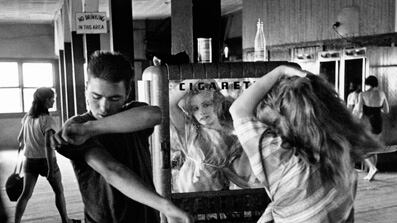Bruce Davidson’s photographs seem to get better with age. While the distance of history adds a kind of poetic seasoning to his graphically bold and affecting early work, the subject matter he sought throughout his career has always corresponded to the social conditions of a time and place. Whether capturing alienated youth, civil-rights activities in the South, or a single street in Harlem, Davidson has come to epitomize a social-documentary tradition in photography that focuses on issues of cultural concern to generate interest in addressing them. Now he is the subject of dual exhibitions in Manhattan: at Bryce Wolkowitz Gallery, a 50-year retrospective; and at Howard Greenberg Gallery, a reconstruction of East 100th Street, his landmark 1970 show at The Museum of Modern Art.
In 1958, at the age 24, Davidson became the youngest member of Magnum, the international photography collective known for socially committed photojournalism. He had first met Henri Cartier-Bresson, one of the founders of Magnum, in the mid-1950s while stationed outside Paris in the Army. Several years later, riding the Fifth Avenue bus in New York, he spotted Cartier-Bresson walking down the street. Davidson jumped off the bus to say hello and that serendipitous encounter would change his life.
Click Image Below to View Our Gallery

Not long after, Davidson was reading a story in the paper about a rumble involving a young street gang from Prospect Park South, at the time a very poor neighborhood in Brooklyn. He got on the subway and went to look for them. Davidson, 76, told me by phone that he remembers taking pictures of their bandages that day. Eventually he would learn the circumstances of their lives: There was a lot of alcoholism among their parents; as teenagers, they didn’t have much of anything to do; there were no services for young people; there wasn’t anybody who cared about them.
Davidson, who was a thin young man, quiet, and stealth-like with his Leica, spent a year photographing the gang members. The body of work, known as Brooklyn Gang, captures the mating rituals, the war dances and the territorial restlessness of an urban adolescent tribe in the late 1950s. It’s easy to get lost in his pictures because of the period cars, clothing, and hairdos, but it’s the palpable emotional content that has such abiding narrative impact.
“It seems as if I need a blank piece of paper for anything I do,” Davidson says, explaining that he doesn’t start with an idea so much as what he calls a cloak of consciousness—something that affects him personally. “That is to say that I work out of a state of mind. I couldn’t photograph that Brooklyn gang of teenagers today because I’m an old man. But, then, I was only a few years older than they were and I felt the same feeling of isolation, of depression, even the anger that they were feeling, so I could relate to them.”
In the early 1960s, Davidson had been hired by Alexander Liberman to shoot fashion for Vogue, and, at the same time, took assignments from Life, Esquire, and other publications. But this editorial work did not “come out of my gut, out of my passion, and out of my purpose,” he would later say, describing the ingredients he determined were necessary for him to engage the subjects of subsequent bodies of work.
At the first real stirrings of the civil-rights movement, Davidson boarded a Freedom Fighter bus from Montgomery, Alabama, to Jackson, Mississippi. There were National Guard troops and a dozen police cars surrounding the bus. “Solemn soldiers stood in the aisle with fixed bayonets,” Davidson wrote about the experience. “During the hours that the bus traveled the deserted, tree-lined highway, there was fear that snipers might fire on the bus.”
Later, in the spring of 1965, he returned to Alabama and photographed the march from Selma to Montgomery, which ended with the murder of a white civil-rights worker. Davidson saw the bloodstained seat of her car and the skid marks where her car had gone off the road. “The violence in the South had reached into me deeper than my personal pain.”
The next year, Davidson embarked on a two-year project photographing an African-American neighborhood on a single street in Harlem— East 100th Street, arguably his best-known body of photographs. Asked about the critical reaction at the time, calling the work exploitative, he recounted an experience when he first started shooting on East 100th Street that he considers a consciousness-expanding moment: “A woman came up to me that first day and, of course, I had this big camera on a tripod. She said, ‘What are you doing?’ and I said ‘I’m photographing the ghetto.’ She said ‘Oh, yeah, but what you call the ghetto, I call my home.’”
This speaks to what Davidson refers to as “the journey of consciousness” he undergoes with each body of work, whether his series on the circus, the subway, or Central Park. By making contact with his subjects and seeing who they are, it brings him to new levels of awareness. On East 100th Street, he took pictures of people in their apartments and gave each of them a print. Then, when the book of photographs was published, he gave every one of his subjects a copy of the book.
What elevates Davidson’s work beyond photojournalism into art is the discernable intelligence behind it. In each series of photographs, Davidson set out to learn as much about himself as his subjects. By waiting and watching and entering these different worlds, he captures in photographic form a deeper existential component to the lives and the circumstances of his subjects. And in doing so, he connects to that level of his own existence, and, in visual terms, ours, as well.
Plus: Check out Art Beast for galleries, interviews with artists, and photos from the hottest parties.
Philip Gefter writes about photography for The Daily Beast. He previously wrote about the subject for The New York Times. His book of essays, Photography After Frank, was recently published by Aperture. He is currently producing a feature-length documentary on Bill Cunningham of the Times, and working on a biography of Sam Wagstaff.






